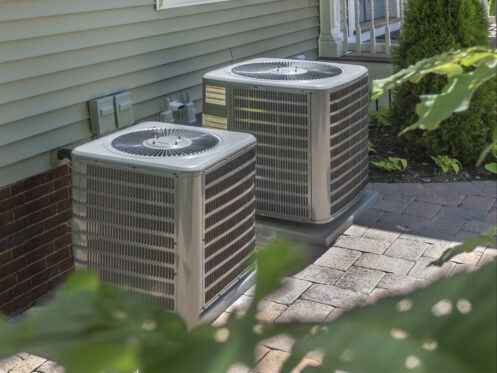As the weather warms up, it’s the perfect time to show your home’s heating, ventilation and air conditioning (HVAC) system some extra care after working hard all winter. Proper seasonal maintenance keeps your HVAC running efficiently, extending its life span and circulating cleaner air indoors. From swapping filters to clearing out growth to checking connections, here are top spring-cleaning recommendations to revitalize your HVAC.
1. Change Filters
Clogged, dirty filters reduce airflow and strain your system unnecessarily by making components work harder to compensate. By replacing air filters in the spring, you help ensure the HVAC components stay cleaner while operating at peak condition. Mark your calendar with reminders so you never forget this crucial maintenance task.
For filters made to be cleaned and reused, ask an expert to remove and gently wash away buildup in warm, mild soapy water instead of harsh cleaning chemicals. Rinse thoroughly before leaving to completely air-dry for a day so no moisture remains when reinserting. Proper care makes reusable filters last longer.
2. Clear Nearby Debris
Consider an expert to walk around your outdoor AC condenser unit, whether wall-mounted or ground-level, and remove any fallen leaves, grass clippings, sticks or other debris littering the area. Carefully clear away anything directly blocking airflow through the condenser coils or fans. Use a soft brush to dislodge debris so metal fins aren’t accidentally bent or damaged if physically pulling out plant matter.
Check the drain pan situated under the condenser coils and evacuate any water if the drain outlet gets clogged. Standing water causes rust and allows moist organic matter like leaves or grass to decay inside the pan, eventually spreading problematic algae growth through the condenser cabinet over time if not addressed. Ensure water flows freely through the drainage line.
3. Professionally Clean Ducts
No matter how good you are about changing filters, inevitably dust and other contaminants passing through your HVAC system still build up inside the ductwork stretching across your home over months and years of use. Hiring professional duct cleaning services every three to five years clears out this accumulated layer of dust, pet dander, pollen and assorted particles for improved indoor air quality and system performance.
While the investment for whole duct system cleaning may seem high up front, restored HVAC airflow capacity and removed debris that would eventually shake loose into your living spaces down the line make the added peace of mind worthwhile. Just be sure to vet any duct cleaners thoroughly via reviews and references to ensure proper methods and equipment are used so internal metal and sealing are never compromised. Resealing damaged ducts adds even more to your costs.
4. Inspect Refrigerant Levels
After running for months on end during warm seasons, refrigerant levels in your AC system can become low either due to very small, undetectable leaks or by design as sealants naturally break down over time. Low coolant/refrigerant translates to reduced ability for your HVAC to effectively cool your home in the summer.
To prevent issues keeping comfortable later, contact our certified HVAC service company serving Lincoln, Omaha and surrounding areas in early spring to come check for any leaks at connections points or damage contributing to coolant loss. Qualified technicians can then measure current refrigerant levels and calculate the optimal amount of refrigerant needed to handle the upcoming peak cooling season. Keeping your AC unit properly pressurized improves efficiency and prevents system strain.
5. Trim Encroaching Growth
Ask an expert to trim back any nearby bushes, tree branches, vines or other plants that have slowly crept closer over the previous growing season. Foliage crowding or directly touching your AC condenser unit can block ventilation while leaves or vines dangling down from overhead can also impede airflow once summer humidity kicks in.
Ideally, you want to maintain at least 24 inches of unobstructed clearance in all directions around the condenser cabinet for optimal airflow. Severely pruning back spring growth ensures mechanical ventilation isn’t hampered as cooling demands rise later, preventing added strain on systems working harder to compensate. Keep vegetation under control to maximize operational efficiency.
6. Check for Leaky Seals
During spring evaluation when systems aren’t running continuously, have an HVAC technician thoroughly inspect the full length of visible refrigerant piping stretches as well as soldered joints or other connection points between the indoor evaporator coil and outdoor AC condenser for any signs of corrosion, damage or leaks. Left unaddressed, small leaks gradually reduce coolant pressure and performance over time.
The technician can peer inside the evaporator coil cabinet housing within the air handler to check for rust formation or cracks around the coil that signal needing replacement before complete failure happens at the worst time. Address the questionable seals or minute leaks now as repairs only become more extensive and costly if left deteriorating further. Proactive attention in the spring makes summer comfort more affordable.
7. Consider Upgraded Filtration
Rather than relying solely on a single disposable filter changed twice a year, upgrading your HVAC filtration capabilities better protects the welfare of your home’s environment and the system itself. Consider installing a whole-house filtration system featuring a washable pre-filter paired with secondary MERV 11-16-rated pleated filters shown to capture far more dust, pollen, pet dander and other contaminants circulating indoors.
While the superior filtration does cost more up front, being able to vacuum and rewash pre-filters while only having to swap out secondary filters every six to 12 months offers savings over time. Moreover, noticeably cleaner indoor air quality and eased strain on HVAC components translates to service savings that help offset upgrade investments in coming years. Treat your home’s lungs kindly!
8. Recalibrate HVAC Controls
An inexpensive but vital spring task involves double-checking that your various HVAC operational controls stayed properly calibrated and functioning over the winter rather than becoming stuck or condensation-damaged. Ensure the thermostat accurately reflects ambient room temperatures and the humidistat keeps relative humidity levels optimized.
For smart app-enabled thermostats, ask experts to verify integrated sensors read correctly and connectivity features like automatic schedule adjustments work reliably as well. Replace thermostat batteries annually to avoid inconvenient summer failures at peak demand. Reprogram updated seasonal settings after testing. Letting controls slip sabotages settings.
9. Schedule Seasonal Servicing
Consider enrolling in discounted seasonal service agreements offered by a reputable HVAC company to promote regular unit evaluations. Contracting with licensed technicians helps ensure every component and connection gets fully assessed to reveal concerns like damaged coils, worn bearings or compressor problems before catastrophic failures hit. An ounce of prevention truly pays off!
John Henry's Plumbing, Heating, Air, and Electrical provides a full range of services beyond seasonal HVAC tune-ups to keep your home comfortable year-round, including drain cleaning, water heater installations, whole-house filtrations systems, and complete replacement of aging HVAC units. In addition to preventative maintenance recommendations, the John Henry's Plumbing, Heating, Air, and Electrical team of trained technicians can diagnose any furnace, air conditioner or thermostat issues that pop up and provide affordable 24/7 emergency repair services for heating, cooling and indoor air quality problems. Call us today to set up your appointment or to learn more.

